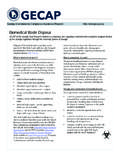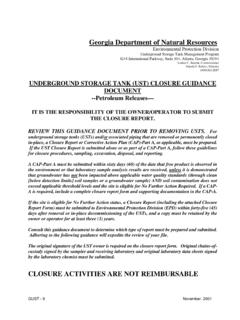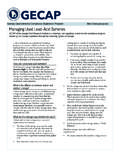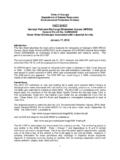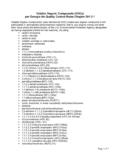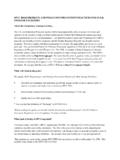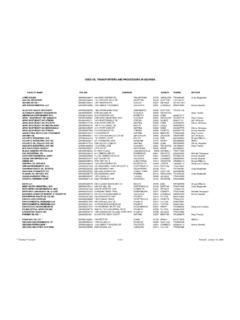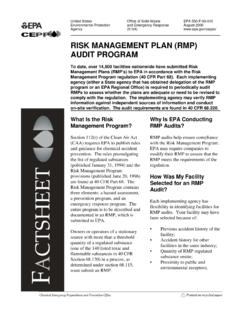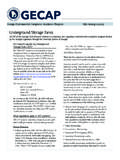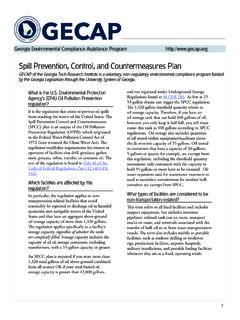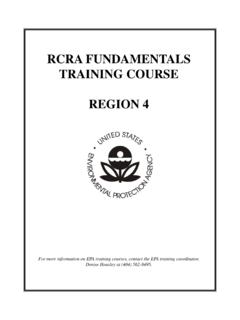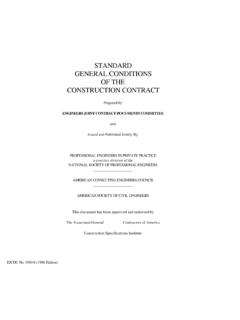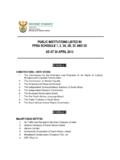Transcription of Understanding the Small Quantity Generator …
1 Understanding the Small Quantity GeneratorHazardous waste RulesA Handbook for Small BusinessesTech WRECP rogramWaste Reduction&Environmental ComplianceThis page is intentionally left on recycled paperTable of ContentsThe Tech WREC Program .. 3 The Resource Conservation and Recovery Act (RCRA) .. 4 What Is a hazardous waste ? .. 5 Listed Wastes .. 5 Characteristic Wastes .. 5 Wastes that May Be hazardous to Health, but Are Not Regulated Under RCRA .. 5 For Assistance and More Information .. 6 Acutely hazardous Wastes .. 7 What You Must Do as a hazardous - waste Generator .. 8 Categories of hazardous waste generators .. 9 Conditionally Exempt Small Quantity generators (CESQG) .. 9 Small Quantity generators (SQG) .. 9 Large Quantity generators (LQG) .. 10 Table 1: Typical waste Streams Generated by Small Quantity generators .. 11 Figure 1: Generator Requirements.
2 13 Counting Your hazardous Wastes .. 15Do Count .. 15Do Not Count .. 15 Changing Generator Categories .. 16 Obtaining a EPA Identification Number .. 17 Figure 2: Notification of Regulated waste Activity Form .. 18 Pre-transport Rules .. 20 Uniform hazardous waste Manifest .. 20 Managing Wastes On 21 Storing hazardous waste On Site .. 21 Treating hazardous waste On Site .. 222 Disposing of hazardous waste On Site .. 22 Obtaining a Permit to Store, Treat, or Dispose of hazardous waste On Site .. 23 Preparing for and Preventing Accidents .. 23 Planning for Emergencies .. 24 Shipping hazardous waste Off Site .. 26 Choosing a hazardous waste Hauler and Designated waste Management Facility .. 26 Preparing Your hazardous Wastes for Shipment .. 27 The Uniform hazardous waste Manifest .. 27 Figure 3: hazardous waste Manifest .. 29 Maintaining a Safe Environment.
3 30 The Four Most Important Things to Remember About Managing Your Wastes Properly30 Reducing hazardous waste .. 30 Working with Inspectors .. 30 Self-Inspections .. 31 Appendix A: hazardous waste Management Offices .. 32 Appendix B:EPA hazardous waste Numbers for waste Streams Commonly Generated by SQGs .. 423 The Tech WREC ProgramThe Tech waste Reduction & EnvironmentalCompliance (WREC) Program of the Georgia TechResearch Institute is a voluntary, non-regulatorytechnical assistance program funded by theGeorgia Legislature through the State UniversitySystem of purpose of this book is to help Small busi-ness owners and managers understand how thefederal hazardous waste management laws affecttheir booklet was prepared by the Tech WRECP rogram using material provided by the UnitedStates Environmental Protection Agency, Office ofSolid waste and Emergency Response.
4 The Gen-erator Compliance Program of the HazardousWaste Management Branch, Georgia Environmen-tal Protection Division, provided technical you have any questions about the Tech WREC program, or need further assistance, please callthe Georgia Tech WREC program at 404/894-3806,or if you would like additional information re-garding the management of hazardous waste ,please contact the Generator Compliance Pro-gram, hazardous waste Management Branch, at404/657 Resource Conservation and Recovery Act(RCRA)In 1976, Congress passed the Resource Conser-vation and Recovery Act (RCRA), directing Environmental Protection Agency (EPA) todevelop and implement a program to protecthuman health and the environment from im-proper hazardous waste management program is designed to control the manage-ment of hazardous waste from its generation toits ultimate disposal from cradle to grave.
5 EPA first focused on large companies whichgenerated the greatest portion of hazardouswaste. Business establishments producing lessthan 1000 kilograms (2,200 pounds) of hazard-ous waste in a calendar month ( Small quantitygenerators or SQGs) were exempted from most ofthe hazardous waste management regulationspublished by EPA in May November 1984, the hazardous Solid WasteAmendments to RCRA were signed into law. Withthese amendments, Congress directed EPA toestablish new requirements that would bringSQGs generating between 100 and 1000 kilo-grams of hazardous waste in a calendar monthinto the hazardous waste regulatory system. EPAissued final regulations for SQGs on March 24,1986, the requirements were effective as ofSeptember 22, Is a hazardous waste ?A waste is any solid, liquid, or contained gas-eous material that you no longer use, and eitherrecycle, throw away, or store until you haveenough to treat and a result of doing business, a company maygenerate wastes that can cause serious problemsif not handled and disposed of carefully.
6 Suchwastes could cause injury, death, or damage, orpollute land, air, or wastes are considered hazardous , andthey are currently regulated by federal and statepublic health and environmental safety are two ways a waste may be brought intothe hazardous waste regulatory system: listingand identification through WastesYour waste is considered hazardous if it appearson any one of the four lists of hazardous wastescontained in the RCRA regulations. These wasteshave been listed because they either exhibit oneof the characteristics described below or containany number of toxic constituents that have beenshown to be harmful to health and the environ-ment. The regulations list over 400 hazardouswastes, including wastes derived from manufac-turing processes and discarded commercialchemical products. Many of the listed hazardouswastes that you are likely to generate are in-cluded in Appendix B of this WastesEven if a waste does not appear on one of theEPA lists, it is considered hazardous if it has oneor more of the following characteristics: ignitability: it is easily combustible orflammable.
7 Examples are paint wastes,certain degreasers, or other solvents. corrosivity: it dissolves metals, othermaterials, or burns the skin. Examples arewaste rust removers, waste acid, alkalinecleaning fluids, and waste battery acid. reactivity: it is unstable or undergoes arapid or violent chemical reaction withwater or other materials. Examples arecyanide plating wastes, waste bleaches, andother waste oxidizers. toxicity as determined by Toxicity Charac-teristic Leaching Procedure (TCLP): thewaste contains high concentrations ofheavy metals, specific pesticides andherbicides, and organic chemicals thatcould be released into the category contains eight heavy metals,four pesticides, two herbicides, and twenty-five organic that May Be hazardous to Health, but AreNot Regulated Under RCRAC ertain hazardous wastes are not regulatedunder RCRA, but are regulated under other of these wastes include PCBs, asbestos,radioactive wastes, and biomedical/infectiouswastes.
8 For more information, contact your stateor federal agency listed in Appendix Assistance and More InformationYour industry may generate other hazardouswastes beyond the examples mentioned above. Itis your responsibility to determine whether yourwastes are hazardous . If you need assistance, call: your state hazardous waste managementagency, listed in Appendix A EPA regional office, listed in Appendix A RCRA/Superfund Hotline800/424-9346in Washington DC202/382-3000 EPA s Small Business Ombudsman Hotline800/368-5888 your national trade association or its localchapter in Georgia, contact the Georgia Environmen-tal Protection Division hazardous WasteManagement Branch at 404/657-8831 or theTech WREC program at 404 hazardous WastesSome wastes are considered to be acutely haz-ardous. These are wastes that EPA has deter-mined to be so dangerous in Small amounts thatthey are regulated the same way as are largeamounts of other hazardous wastes.
9 Acutelyhazardous wastes, for example, may be gener-ated using certain pesticides. They also includedioxin-containing your business generates more than 1 kilogram(approximately pounds) of acutely hazardouswastes in a calendar month or stores more thanthat amount for any period of time, you aresubject to all of the regulations that apply togenerators that generate more than 1000 kilo-grams of hazardous waste per calendar one of the sources of information listedin Appendix A for more information aboutacutely hazardous You Must Do as a hazardous -WasteGeneratorOnce your company determines that it is gener-ating hazardous wastes, you should determine your Generator status; notify your state environmental office, forexample the Georgia Environmental Protec-tion Division (GA EPD), of the hazardouswaste activities; obtain an EPA Identification Number (inGeorgia, obtain a Generator IdentificationNumber [GIN]) if your company generates220 pounds or more of hazardous waste ina calendar month; comply with pre-transport rules; manifest and maintain accuraterecordkeeping and reporting; make an ongoing effort to minimize of hazardous waste GeneratorsIn March 1986, the federal rules for hazardouswaste management were modified to bringbusinesses that generate Small amounts ofhazardous waste into the regulatory , these Small Quantity generators thatgenerate less than 1000 kilograms (or about2,200 pounds) of hazardous waste in a calendarmonth had been exempt from most hazardouswaste 1986 rules set new requirements specificallyfor those generators that generate between 100and 1000 kilograms of hazardous waste in acalendar month.
10 There are three categories ofhazardous waste generators : conditionally exempt Small Quantity genera-tors (CESQG) generate no more than 100kilograms/month; Small Quantity generators (SQG) generate 100or more and less than 1000 kilograms/month; large Quantity generators (LQG) generate1000 kilograms or more in a : 1 barrel = approximately 200 kilo-grams of hazardous waste , which isabout 55 gallons. This representationassumes the waste is water based(weighs pounds per gallon). Yourwaste could weigh significantly more or lessdepending on the density of the Exempt Small Quantity generators (CESQG)If you generate no more than 100 kilo-grams (about 220 pounds) of hazardouswaste and no more than 1 kilogram(about 2 pounds) of acutely hazardouswaste in any calendar month, you are a hazardous waste laws require you to: identify all hazardous wastes you generate send this waste to a hazardous wastefacility or a landfill or other facility ap-proved by the state for industrial or munici-pal wastes never accumulate more than 1000 kilogramsof hazardous waste on your Quantity generators (SQG)If you generate more than 100 and less than1000 kilograms (between 220 and 2,200 pounds)of hazardous waste and no more than 1 kilogram(about 2 pounds) of acutely hazardous waste inany month, you are a SQG.
